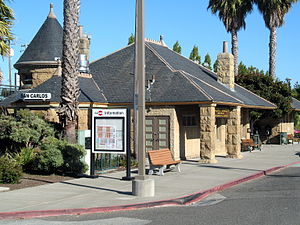
Caltrain is a commuter rail line in California, serving the San Francisco Peninsula and Santa Clara Valley. The southern terminus is in San Jose at the Tamien station with weekday rush hour service running as far as Gilroy. The northern terminus of the line is in San Francisco at 4th and King Street. Caltrain has express, limited, and local services. There are 28 regular stops, one limited-service weekday-only stop, one weekend and holiday-only stop (Broadway), and one football-only stop (Stanford). While average weekday ridership in 2019 exceeded 63,000, impacts of the COVID-19 pandemic have been significant: in June 2024, Caltrain had an average weekday ridership of 24,580 passengers.

Millbrae station is an intermodal transit station serving Bay Area Rapid Transit (BART) and Caltrain, located in Millbrae, California. The station is the terminal station for BART on the San Francisco Peninsula, served by two lines: The Red Line before 9 pm and the Yellow Line during the early morning and evening. It is served by all Caltrain services. The station is also served by SamTrans bus service, Commute.org and Caltrain shuttle buses, and other shuttles.
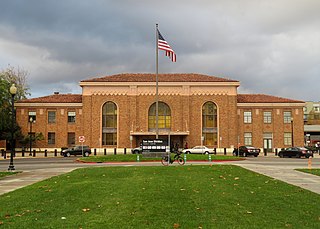
San Jose Diridon station is the central passenger rail depot for San Jose, California. It also serves as a major intermodal transit center for Santa Clara County and Silicon Valley. The station is named after former Santa Clara County Supervisor Rod Diridon Sr.
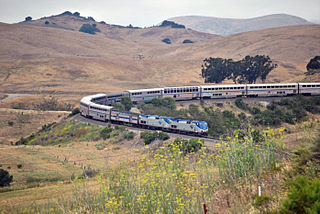
The Coast Line is a railroad line between Burbank, California and the San Francisco Bay Area, roughly along the Pacific Coast. It is the shortest rail route between Los Angeles and the Bay Area. Though not as busy as the Surf Line, the continuation of the Coast Line southbound to San Diego, it still sees freight movements and lots of passenger trains. The Pacific Surfliner, which runs from the San Diego Santa Fe Depot to San Luis Obispo via Union Station in Los Angeles, is the third busiest Amtrak route, and the busiest outside of the Northeast Corridor between Washington D.C. and Boston.

Downtown Mountain View station is an intermodal transit station providing public bus and rail service, located in Mountain View, California. The station is served by the Caltrain commuter rail service, for which it is simply called Mountain View station. Santa Clara VTA Orange Line light rail service is provided to an adjacent, dedicated light rail facility, known as Downtown Mountain View station. VTA local transit bus and employer-operated shuttle services are accommodated from the Mountain View Transit Center on the Evelyn Avenue side of the station.

Santa Clara Transit Center is a railway station in downtown Santa Clara, California. It is served by Caltrain, Amtrak Capitol Corridor, and Altamont Corridor Express (ACE) trains. It is the planned terminus for the Silicon Valley BART extension into Santa Clara County on the future Green and Orange Lines. The former station building, constructed in 1863 by the San Francisco and San Jose Railroad, is used by the Edward Peterman Museum of Railroad History.

The Fullerton Transportation Center is a passenger rail and bus station located in Fullerton, California, United States.

Palo Alto station is an intermodal transit center in Palo Alto, California. It is served by Caltrain regional rail service, SamTrans and Santa Clara VTA local bus service, Dumbarton Express regional bus service, the Stanford University Marguerite Shuttle, and several local shuttle services. Palo Alto is the second-busiest Caltrain station after San Francisco, averaging 7,764 weekday boardings by a 2018 count. The Caltrain station has two side platforms serving the two tracks of the Peninsula Subdivision and a nearby bus transfer plaza.

22nd Street station is a Caltrain commuter rail station located south of 22nd Street between the Dogpatch and Potrero Hill neighborhoods of San Francisco, California beneath the Interstate 280 freeway viaduct. The only below-grade Caltrain station, it is bracketed on the north and south by two tunnels which take the line under the eastern slope of Potrero Hill. The station is also served by Muni routes 48 and 55.

Bayshore station is a Caltrain commuter rail station in the Visitacion Valley neighborhood of San Francisco, California. The station is on the border of San Francisco and the neighboring city of Brisbane. The parking lot and the northern section of the station are in San Francisco, while the remainder is in Brisbane. The station address is in San Francisco proper.

College Park station is a limited-service, weekday-only Caltrain station serving the College Park neighborhood and the Bellarmine College Preparatory school in San Jose, California.

South San Francisco station is a Caltrain station in South San Francisco, California. The station is on the east side of the Bayshore Freeway, east and south of the curved Grand Avenue overpass, and north of where the freeway crosses over the tracks. Downtown South San Francisco is to the west, across the freeway. It previously underwent a substantial modernization and expansion project, completed in January 2022.
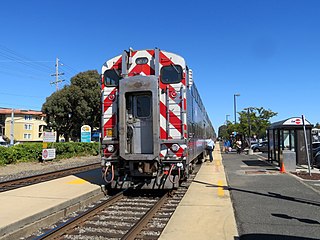
Broadway station is a Caltrain station in Burlingame, California. Caltrain only serves the stop on weekends and holidays; weekday service is provided by a bus shuttle to nearby Millbrae station.
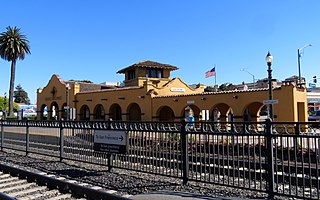
Burlingame station is a Caltrain commuter rail station in Burlingame, California. The station building was constructed in the Spanish Colonial Revival and Mission Revival architecture styles in 1894, opening for service on October 10 of that year. 18th-century tiles from the Mission San Antonio de Padua at Jolon and the Mission Dolores Asistencia at San Mateo were used for the station roof.
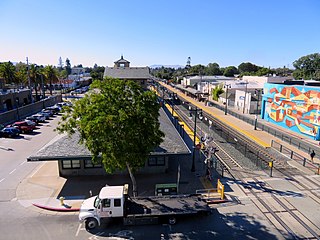
San Mateo station is the northernmost of the three Caltrain stations in San Mateo, California. It is in downtown San Mateo.

Gilroy station is a Caltrain station located in Gilroy, California, United States. It is the southern terminus of the South County Connector service, and is only served during weekday rush hours in the peak direction, with trains going toward San Jose in the morning and returning southbound in the evening. The station building was constructed by the Southern Pacific Railroad in 1918 and restored in 1998. Future plans call for extended Amtrak Capitol Corridor service, as well as California High-Speed Rail trains, to also stop at Gilroy. The station was named to the National Register of Historic Places in 2019 as Gilroy Southern Pacific Railroad Depot.
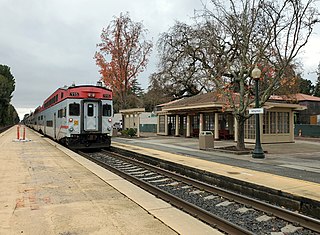
Atherton station was a Caltrain station in Atherton, California. The station had one side platform and one island platform serving the two tracks of the Peninsula Subdivision, with a concrete and wooden shelter on the west side of the tracks. The station opened by the Southern Pacific Railroad in 1866 as Fair Oaks and was renamed Atherton in 1912. Caltrain cut weekday service to the station in 2005 due to low ridership and a hold-out rule that prohibited two trains from being at the station simultaneously. Weekend and holiday service continued until December 19, 2020.

Menlo Park station is a Caltrain station located in Menlo Park, California. The station was originally built in 1867 by the San Francisco and San Jose Railroad and acquired by the Southern Pacific Railroad. During the 1890s, Southern Pacific added Victorian ornamentation to the depot to make it appear more attractive to students and visitors to Stanford University. The station was added to the National Register of Historic Places in 1974, and became a California Historical Landmark in 1983.

The Portal, also known as the Downtown Rail Extension (DTX), is a planned second phase of the Salesforce Transit Center. When complete, it will extend the Caltrain Peninsula Corridor commuter rail line from its current northern terminus at 4th and King via a 1.3-mile (2.1 km) tunnel. The new terminus will be near the Financial District and will provide intermodal connections to BART, Muni, Transbay AC Transit buses, and long-distance buses. In addition, the California High Speed Rail Authority (CHSRA) plans to use DTX and the Caltrain-owned Peninsula Corridor for service on the CHSRA San Francisco–San Jose segment. The Caltrain Modernization Program (CalMod), which included electrification of the line and acquisition of electrified rolling stock, was a prerequisite, since the former diesel locomotives were not suitable for use in a tunnel.

